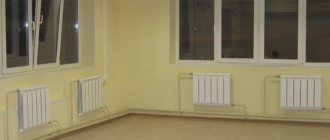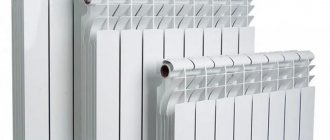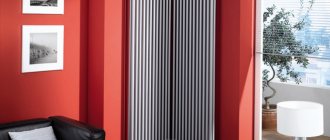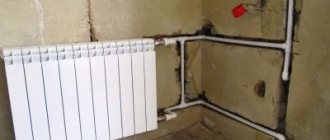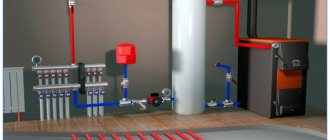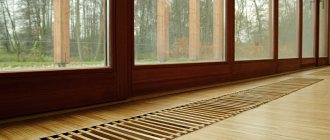Pros and cons of vertical radiators
Vertical radiators with bottom connections have the main advantage of being able to be installed on any free section of a partition or wall; they were invented for this purpose.
There is a wide range of similar products on the market; you can choose one to suit every taste and any room design. In this case, the battery will serve not only as a heater, but also as an additional decoration for the room. The second undoubted advantage is the heating of the entire zone with radiant heat as tall as a person. That is, an aluminum or steel tubular radiator 2 m high, mounted as close to the floor as possible, will distribute infrared heat throughout the room to its entire height. Only for the intensive release of the radiant component one condition is required: the coolant must be heated to a temperature of at least 50 ºС.
And the last thing is functionality. In fact, a vertical heating radiator can not only serve as a decorative element, but also perform some kind of function. For example, among the many products offered, there are models with a heated towel rail, clothes hanger, mirror, and so on. Now about the shortcomings, of which there are also many:
- High price. Even the simplest vertical device will cost more than a traditional one of the same power.
- Air cushion near the ceiling. A radiator that is too high creates weak convective air movement in the room. The way out is to use additional heating sources with forced air circulation.
- Heavy weight. This is especially true for tall steel batteries; they cannot be hung from any partition. In conventional plasterboard systems, embedded parts must be provided in advance for this purpose.
- Difficulty in installation and connection. It is inevitable when all fastenings, suspensions and connections need to be hidden as much as possible.
- Reduced heat transfer. Such tall batteries are not able to warm up evenly, which entails a slight decrease in efficiency.
Advantages and disadvantages of vertical radiators
Vertical radiators are a controversial option for a heating system. Their installation requires the presence of a free wall in the room and the possibility of discreetly connecting coolant pipes to the radiator.
Some models of vertical radiators can be used as hangers, shelves or mirrors in summer. Batteries may also include the ability to backlight
Despite this, vertical batteries continue to be in stable demand due to the following advantages:
- High level of heat transfer due to the large area of contact with air. This allows you to heat the coolant to a lower temperature and not overload the gas boiler.
- A variety of shapes , sizes and colors , which allows you to choose a model of the required size for any interior interior.
- High speed of heating of rooms due to contact with air over the entire height of the room. Aluminum appliances are particularly effective in this regard.
- Easy installation due to the mounting kit included with each battery.
- Save space under the window where you can arrange a small storage room.
With a stained glass wall structure and the absence of a window sill, vertical wall radiators are an ideal option for installing a heating system.
Vertical heating devices are not without their drawbacks, which is why they are not widely used.
The disadvantages of such batteries include the following:
- Uneven heating . Due to the vertical elongation of radiators, warm air from them rushes to the ceiling and accumulates there. As a result, the floor does not warm up well and remains cold.
- High price . The price of one simple vertical section 2 meters long is 60-150 dollars, and designer models cost several times more.
- The difficulty of installing heating pipes unnoticed . Ideally, plastic wiring for vertical radiators should run inside the walls behind the drywall, but this is quite difficult to implement.
- The large weight of steel models , which does not allow the battery to be hung on plasterboard and thin interior partitions.
- Vertical radiators are usually connected using a bottom or saddle circuit, which reduces the level of heat transfer by 10-15% compared to diagonal or side installation.
There are no fundamental design differences between horizontal and vertical batteries.
The disadvantage of hidden installation of vertical radiators is that if the pipe breaks, you will have to completely dismantle the wall with all the interior decoration
The latter simply have an elongated shape of the intra-sectional channels. Therefore, when choosing radiators for a heating system, you must be guided mainly by external beauty and ease of installation of equipment.
Manufacturers
Among the most popular manufacturers of heating radiators, the following should be highlighted:
Conner. Country of origin: Russia. This brand produces high-quality cast iron batteries that are not inferior in quality to their European counterparts, but are adapted for use in domestic conditions. Among the advantages of the products are resistance to water hammer and high-quality anti-corrosion protection of internal surfaces. The collections include many products of various shapes and designs, and there is a special line of retro-style batteries.
In addition to cast iron, the manufacturer also produces bimetallic and aluminum batteries of various modifications.
- GuRaTec are German cast iron batteries, which, due to their perfect appearance, are often called a real work of art. High performance characteristics are achieved through the use of the latest engineering developments and impeccable workmanship. The devices are produced in retro style, have many modifications, and the maximum height is 970 mm.
- Roca is one of the most famous Italian manufacturers of plumbing and heating systems. The company has no subsidiaries outside Spain, which guarantees the original quality of the products and their compliance with European quality and safety standards.
- Buderus is a company that has a solid history (founded in 1731), so its products are characterized by the highest quality. For a long time, the manufacturer produced cast iron heating devices, but today the range also includes 2 types of steel radiators. A special feature of the product is that the batteries are equipped with systems for quick installation.
- Kermi is another German manufacturer that has received positive feedback from domestic buyers. The range is represented by steel radiators. In addition to high quality, they are distinguished by a wide variety of shapes and designs. These can be vertical panel radiators of any size, design radiators, and even entire wall radiators.
The products are manufactured exclusively in Germany, which guarantees strict quality control of radiators.
Korado is a Czech manufacturer, one of the world leaders in the production of heating devices. Vertical radiators can be found in the RADIK VERTIKAL line. These are steel products, standard white. However, if the client wishes, they can be painted in one of the shades from the catalog, which includes 21 colors.
Style Retro - Russian-made cast iron batteries that imitate ancient (19th-early 20th centuries) heating devices. In addition to functionality, they also have an aesthetic appearance and often become a decorative element of the interior. Patterns on the surface are made using artistic casting in accordance with the selected style of radiators.
Painted batteries, which can be made using the Gzhel technique, or have a gold pattern on red or black, evoke admiration. The company also manufactures and paints custom batteries. The products have high performance characteristics, while they are characterized by a lower cost than their Western counterparts.
Installation features. Useful tips
Installing radiators yourself is not that difficult. It must be taken into account that vertical structures are more bulky and will take more time to install them under the ceiling. All wall-mounted heating devices, regardless of model and design features, are attached to the wall using brackets and connected either to the hot water pipeline or to the power supply network.
What you need to pay attention to when installing vertical heating devices:
- vertical models are heavier than horizontal ones, so they need to be placed only on a load-bearing wall;
- It’s good if you can hide the pipes in plasterboard structures or drown them in grooves. If not, bring the pipes to the bottom of the radiator. This way the design will look more aesthetically pleasing;
- install a jumper that regulates the heat intensity;
- be sure to install chokes and valves so that, if necessary, you can completely turn off the radiator;
- Do not combine copper pipes with aluminum. These metals form a galvanic couple in salt water conditions. Connect aluminum radiators to hot water supply using steel or propylene pipes;
- Aluminum models are not suitable for electrical systems. Current destroys metal much faster;
- the air vent is installed in the upper tube if the suspension is located at the bottom of the battery;
- propylene pipes installed below may not withstand the pressure due to the fact that it is concentrated at the bottom of the radiator. In this case, it is necessary to install a compensator to smooth out the expansion. Thus, the pipes are not deformed when exposed to high temperatures;
- If you need to paint batteries, choose only heat-resistant materials. This applies to both paints and varnishes.
Peculiarities
It is logical that heating radiators are called vertical, the sections of which are located vertically. However, most batteries have a similar arrangement; devices with horizontally oriented sections are quite rare. In this regard, it is more correct to base the criterion on the shape of the rectangle formed by the batteries.
Thus, vertical batteries are those that form like a horizontally elongated rectangle. A distinctive feature of such systems is their orientation in height with a reduced width.
Thanks to this arrangement, it is possible to fit such batteries even into a small space, maintaining the required amount of thermal energy. The systems can be located almost from the floor to the flow, up to the height of a person. By spreading infrared thermal radiation (similar to solar heat) at the height of a person, they provide increased indoor comfort.
Vertical batteries have many design options and are distinguished by a variety of designs and colors. This allows you not only to fit them into any room, but also to make them an original interior detail. Such batteries, installed instead of the usual models placed under the windowsill, can not be hidden, but placed in any convenient place. In addition to practical, they perform a decorative function.
When choosing vertical radiators, it is useful to know about their disadvantages. With this heating method, the principles of convection are violated, and therefore warm air accumulates under the ceiling, which is irrational. And when the batteries operate intensively, this warm air becomes the cause of an unfavorable microclimate. In addition, the likelihood of air pockets in the internal channels of vertical batteries increases.
Finally, installation of such a system is more labor-intensive. Even a slight vertical deviation will be noticeable and will disrupt the aesthetics. Difficulties arise with the installation of heating circuit pipes. In this case, you will have to abandon the most effective diagonal connection scheme. Otherwise, you will have to embed pipes into the walls, which is unaesthetic and unsafe in case of an accident.
The solution is to use a lower connection, which is not as effective and efficient as a diagonal one. In addition, vertical batteries require a reliable, powerful mounting system.
Vertical heating radiators
There are several types of heating radiators, differing in appearance, material of manufacture and installation method. The most popular modifications include vertical radiators .
For the manufacture of such structures, steel, cast iron, aluminum are used; bimetallic models are also in great demand. Modern production technologies ensure long battery life and improve their performance characteristics.
Vertical heating radiators are painted in various shades and can have an individual picture or poster, which makes it possible to select options that fit organically into the interiors. If earlier batteries often spoiled the appearance of premises, today they are becoming an attractive interior component.
There are models that provide different options for piping - from the sides, in the center or from the bottom. Manufacturers offer radiators that can operate from an electrical network; they are filled with antifreeze or ethylene glycol.
How to choose vertical radiators?
When choosing the most important elements of heating systems, you should be guided by several parameters, primarily power and throughput. The connection method also matters. It is important to know the parameters of the heating system in your home: workload, pressure level, temperature fluctuations.
deserve special attention .
Tubular vertical radiators
The main advantages of such devices include:
- attractive design;
- Possibility of use in residential and work premises;
- excellent technical parameters, including resistance to pressure drops and high heating speed.
In such radiators, tubes combine the upper collector with the lower one, thereby achieving effective coolant circulation. The degree of heat transfer depends on the size of the radiator, cross-section and number of tubes in a row. Installation takes minimal time; each battery comes with a set of fasteners, which speeds up installation.
Such products, as a rule, do not accumulate dust, dirt falls down due to the smoothness of the walls, tubular radiators are easy to keep clean, and they take up little space. Due to the high quality of joints created by welding, the likelihood of leaks is eliminated.
With high-quality radiators with maximum heat output, your home will always be warm.
All decorative radiators presented in the catalog of our store are provided with a long-term guarantee.
Radiator manufacturers
Vertical heating radiators GUARDO, Purmo, Loten Grey, Isan, Irsap, Piano forte, Savva are available in more than 300 models of any colors and to suit any of the most daring design solutions. Prompt delivery and installation services.
How to choose?
The decisive criterion when choosing a heating radiator is its heat transfer. The power of the system is selected taking into account the area of the room, the presence and number of walls in contact with the street. You should also take into account whether the walls face the south or north.
For an apartment where the likelihood of water hammer occurring is higher than in a private house, it is better to choose cast iron or bimetallic products. For unusual interiors, you can choose designer radiators, while simple chrome-plated batteries will fit into almost any interior.
If we are talking about steel tubular products, then preference should be given to domestic options. They have a wall thickness of 2 mm and can withstand a pressure of 20 atmospheres. Foreign analogs can withstand pressure of only 15 atmospheres with a wall thickness of 1.5 mm.
Among steel elements, tubular systems are considered the safest. However, they also have vulnerable points - welds. In general, when using steel radiators, it is recommended to equip them with gearboxes that allow you to control temperature indicators and constant coolant pressure.
Features of installing high radiators
Installing vertical radiators is not much different from installing a conventional battery. They can also use underwater pipes made of steel, polypropylene or polyethylene. But still, there are small installation subtleties. Since the coolant has a large area, and therefore weight, it must be fixed only to a solid wall that can withstand the large weight of the product. In addition, when choosing a radiator with a top connection, you should take into account that the pipe will run along the entire height of the radiator and spoil the overall aesthetics of the room with its appearance.
You can select and buy vertical radiators for heating in the Dom-Termo online store. You will be surprised by the variety of models and their affordable prices.
Disadvantages of vertical radiators
Like any other heating devices (and not only heating ones), tall radiators, in addition to their advantages, also have their disadvantages.
Cannot be installed under a window. Vertical batteries cannot, like horizontal ones, be placed directly under the window. Therefore, for them it is necessary to provide a free section of the wall (from furniture and other interior items), which is problematic for small rooms or smart apartments.
Price. If we compare tall radiators with trench convectors (if the convectors are also made in Europe), then the former will be much more affordable. If we compare vertical heating devices with horizontal ones (especially if the latter are made in China or Ukraine), then the former will be much more expensive. But this minus is fully justified by the heating comfort and the quality of manufacturing of the vertical radiators. Therefore, if you are “Not rich enough to buy cheap things,” then vertical radiators are designed just for you.
Advantages
In addition to various design solutions, tall radiators have several more advantages:
- at low media temperatures, they provide the highest possible heat transfer;
- Due to their light weight and the use of small volumes of water, the devices reduce energy costs;
- radiators are equipped with regulators that allow you to independently set the temperature;
- When installing devices with lower communication lines, the aesthetic appearance of the room is preserved.
The advantages of these models include the fact that while saving space, you can install several heating devices in one room at once.
How to choose a radiator based on its thermal power
Original appearance, good compatibility with the chosen style of room decoration - all this is very important. But still, the determining criterion for choosing the optimal model for a specific room should be the heat transfer of the radiator, that is, its ability to compensate for heat loss in order to ensure a comfortable temperature in any weather conditions outside
Below, the reader will be offered a calculator for calculating the required power of a radiator purchased for a specific room. To avoid any questions, here are a few explanations on how to carry out the calculations:
- The area of the room - the larger it is, the more powerful heating devices are required.
- The presence and number of walls in contact with the street - the amount of heat loss in the room directly depends on this.
- External walls facing the sunny side receive an additional thermal “charge”, unlike the northern ones.
- Windward walls (relative to the direction of the most frequent winter winds) cool faster.
- The minimum temperature level is taken to be normal values for a given region, characteristic of the coldest period.
- Insulation of external walls can be considered complete when it is carried out in full on the basis of thermal engineering calculations. Uninsulated walls, although indicated in the calculator, in principle, should not be considered at all, since with this approach heating of any power will not become effective.
- Ceiling height – the volume of the room depends on it.
- The amount of heat loss through the ceiling and floor depends on what is located above and below the room in question.
- The block of fields dedicated to windows allows you to evaluate the degree of their thermal insulation and the total glazing area, on which, in turn, the correction factor to the required heating power depends.
- Through doors opened onto the balcony or street, masses of cold air enter the room, which requires a certain thermal compensation due to heating.
The last section of the calculator examines the features of installing radiators:
- The efficiency of heat transfer from batteries depends on their connection to the heating circuit. For vertical batteries, not all schemes are convenient, but as an example, you can compare the benefits or losses from one or another type of connection.
- It has already been mentioned that vertical radiators are not efficient in creating convection heat flows, and their heat transfer is often limited by thermal radiation. In some cases, this may clearly not be enough, so such models are often used in combination with traditional heating radiators or other heating devices (for example, electric) in order to achieve the total thermal power required for a particular room. For such a calculation, if this path is chosen, a window will appear for entering the available or planned power of other heating devices, and the final value of the calculator in this case will show the power of the vertical radiator, which will fully fill the remaining “deficit”.
The calculator allows you to get one of two different results:
- If the calculation is carried out for a non-separable model, then the result “A” should be taken - in kilowatts.
- When purchasing a collapsible radiator, you usually calculate the required number of sections. If this calculation path is selected, a field will appear in which you must enter the nameplate power of one radiator section. The final result under the letter “B” is the required number of sections, rounded up to the nearest whole number.
The required operational reserve has already been included in the final value.
Appearance of low heating radiators
Appearance of a low radiator
The modern manufacturing market offers various designs and color solutions for heating radiators. This type of product can also be selected according to the following parameters:
- to size;
- optimal length;
- convenient width;
- required power;
- and also by the number of sections.
According to technical parameters, this type of product is suitable for equipping heating systems of any premises. One of the undoubted advantages of these devices is the high-quality final finishing of the surface coating of heating radiators. This can be a specialized varnish, spraying or paint.
This nuance ensures resistance to corrosive processes, and this treatment does not require regular painting or other types of maintenance. High-quality devices in this area save up to 30 percent of material costs for heating needs.
Radiators are produced in a variety of versions to meet the different requirements and preferences of customers for this type of product. This assortment allows you to choose the most successful option for installing low batteries in a certain room, moreover, it is beneficial both during installation and is suitable for certain heating systems.
The best manufacturers of vertical radiators
According to customer reviews, the best manufacturers of vertical equipment include the following category:
- Arbonia;
- Bethatherm;
- Jaga;
- Caleido;
- Enix;
- Korado;
- Fondital;
- Global;
- ECA
Design and characteristics of vertical radiators
The structural structure of vertical heating devices is similar in basic positions to solutions of the classic horizontal type. Traditionally, radiators are installed under a window sill, but when arranging rooms with panoramic windows, high wall radiators are often chosen. The height of the equipment, depending on the modification, varies between 1-3 meters. Non-separable and collapsible structures are made, the latter can be expanded by adding additional sections, or a certain number of extra segments can be removed.
A heating system using vertical batteries should be planned at the stage of construction or major repairs, otherwise installation work will be accompanied by difficulties due to problems with masking communications.
Classification of heating radiators
Vertical radiators are classified according to the material of manufacture, external design and type of heat source. These devices have a height of 1-3 meters and are similar to their horizontal counterparts with the exception of some features.
According to the material of manufacture
Vertical heating devices have quite large dimensions and weight, so manufacturers try not to increase the load on the walls due to sections made of cast iron.
In addition, the complexity of processing this metal does not allow it to be given decorative shapes. These factors rule out cast iron as a material for making tall batteries.
It is advisable to plan a heating system from vertical radiators at the stage of building a house or major renovation of an apartment, so that communications can be hidden behind the walls
The main types of vertical radiators, depending on the material of manufacture, are:
- bimetallic;
- aluminum;
- steel.
Modern bimetallic heating devices are good because their tubes and system of internal channels are made of steel, and the heat-emitting fins are made of aluminum. This allows you to combine the strength and wear resistance of one metal and the good heat-conducting properties of another in one device.
Bimetallic vertical batteries are highly reliable because they contain a minimum of threaded connecting elements that can leak
In addition, the ease of machining aluminum allows you to vary the appearance and shape of radiators within a wide range. This metal can be painted well without losing its thermal conductivity properties, which makes it possible to integrate products made from it into an interior made in any palette.
The only disadvantage of bimetallic products is their increased cost. Steel heating sections are characterized by increased structural strength, but among all vertical radiators they have the worst heat transfer.
Steel does not lend itself well to precise machining, so the appearance of batteries made of steel alloys is often not distinguished by sophistication. In addition, steel structures are susceptible to corrosion, even if they are coated with a special coating.
Tubular steel radiators can have from two to six channels per section, so the battery can be made narrow but deep
Steel sections are often manufactured in panel construction, allowing pipes and ducts to be hidden behind external metal plates. The advantage of such radiators is their price, which is lower than that of products made from other materials.
Aluminum heating sections have the best thermal conductivity among other materials. They heat up quickly, but don't hold heat for long. Aluminum is a plastic material, so batteries made from it are distinguished by their exquisite design forms.
Aluminum vertical radiators are the lightest, so they can even be mounted on interior partitions without the risk of deformation.
Due to the ease of manufacture, the cost of aluminum radiators is lower than bimetallic ones, but their maximum operating pressure is also lower. Weak strength does not allow the use of such radiators in multi-storey buildings and in centralized heating systems.
The material of the batteries can influence their choice only at high operating pressure, so most often products are purchased based on their appearance and cost.
According to external design
The larger the heat-reflecting surface area of the heating metal elements, the higher their efficiency. Therefore, the shape of the battery design largely determines its energy performance.
All radiators according to their external design are divided into:
- sectional;
- tubular;
- panel.
Tubular vertical batteries consist of elongated pipe sections connected at the top and bottom by collectors. To give an elegant look, individual radiator elements are often curved. This device provides maximum heat transfer, but to preserve it, it is necessary to regularly wash the batteries on all sides.
The advantage of tubular structures is the possibility of arbitrary bending of the channels, which allows you to create elegant shapes without sacrificing reliability and price
Such radiators are usually made of steel, and individual pipes are connected to the collector by welding. Sectional batteries consist of several parts with a flat front surface.
They are characterized by the following features:
- are predominantly bimetallic or aluminum, which compensates for the reduction in working area when comparing their performance with tubular models;
- fit aesthetically into the interior;
- are more expensive than other types of batteries;
- give off heat primarily by convection;
- are collapsible, which allows you to assemble an arbitrary number of sections in one battery.
Caring for sectional radiators is simple and does not require much time.
The width of sectional vertical radiators can be arbitrarily changed by adding new sections. With the help of a special key, every owner can do this
Panel batteries have a non-separable design, and their front panel is often represented by a single sheet of metal or glass. Particularly popular are models with mirrored front surfaces, which are independent interior items. They expand the space of the room, adding light and internal warmth.
Panel radiators have a minimal contact area with air, but have a refined shape and are easy to clean the surface
In the presence of an autonomous heating system, the energy efficiency of vertical radiators of various designs is not of fundamental importance, because the heat produced by the boiler will in any case remain indoors.
The following article is devoted to the issues of choosing the best heating devices, which examines in detail the technical characteristics and the pros and cons arguments.
By type of heat source
Most vertical heating devices use water as a coolant, which is heated by a gas boiler. But there are batteries that use electrical energy for heating. Their internal structure is similar to that of water batteries, only a special oil plays the role of coolant.
Electric models pose a certain danger to children. In addition, they are quite powerful, so if installed poorly, the wiring may catch fire.
The use of vertically oriented electric radiators is economically expensive, so they are used primarily for short-term auxiliary heating of premises.
Such equipment has built-in thermoregulation mechanisms, which allows it to be used only when the temperature drops below a set level.
Variations and performances
The range of heating batteries is extensive. There are also apartments with a centralized system and a private house with autonomy. It is most correct to call vertical radiators high varieties of heating devices. Their main feature is their dimensions – their height is much greater than their width.
Structurally, in stores you can find both sectional and non-separable monoblock vertical batteries. And according to the material they can be:
- cast iron;
- aluminum;
- steel;
- bimetallic.
After all, with such dimensions, a device made of heavy cast iron weighs a lot. But all other materials are widely used. For any heating system and features of the chosen style, there is a device in a vertical design.
In addition to connecting from below, tall batteries are connected, like all other analogues, in a lateral and diagonal pattern. But it is the lower liner that allows you to hide the heating pipes so that they do not spoil the interior with their ugliness.
Advantages and disadvantages
What awaits apartment owners who decide to install vertical battery models? In terms of heat transfer, no surprises are expected. According to this indicator, both models differ little from each other.
pros
Vertical batteries have several undeniable advantages over horizontal models:
- Attractiveness of designs. Such models fit into any interior, so you don’t have to think about how to hide them.
- Large heat transfer area, due to which the air in the room warms up faster.
- Structures of this type can be installed almost anywhere, not just near a wall with a window.
- Light weight does not create problems during transportation and installation.
- Thanks to the various types of fasteners, you can choose exactly those that suit the characteristics of the load-bearing wall where the battery will be installed.
- The installation technique is so simple that vertical heating radiators can be easily installed independently, without the help of specialists.
Minuses
Such models also have many disadvantages:
- The air is heated unevenly. The main heat comes from the ceiling. The radiator itself also warms up better in the upper part, the lower part is always colder.
- Most of the heat accumulates under the ceiling of the apartment, so that even distribution of warm air throughout the room is impossible.
- High price.
In terms of heat distribution, a battery of the same size, but located horizontally, is much more efficient than a vertical one.
Variety
Vertical radiators are divided into three types according to the material of manufacture.
Bimetallic batteries
They are special in that their tubes and internal channel system are made of steel alloy.
- In this case, the heat fins, which perform the function of radiating heat, are made of aluminum.
- This allows the system to withstand corrosion and transfer heat to the room in full.
- Also, a battery of any design can be created from aluminum alloy, and the color of the radiator can be of any palette.
Since this material can be easily painted and applied to any, even picky interior design. This heating system is distinguished by its high cost.
Steel batteries
Radiators made of steel are rarely found in exquisite design. Mostly, manufacturers offer simple, unpretentious design options. This is explained by the fact that this alloy is difficult to machine.
In addition, this type of battery quickly fails due to its inability to resist corrosion even with an additional protective layer.
Manufacturing sections also have their differences. They are produced in panel design, hiding pipes and channels behind metal. This all justifies the inexpensive cost of this equipment.
Aluminum batteries
This is an ideal option for vertical heating radiators for an apartment. They have a fairly low cost, but the heat transfer power in this case also suffers. They are also lightweight and weak in strength. But they are in high demand among consumers in the heating equipment market.
Two main disadvantages
- High price.
- Reduced efficiency.
As a rule, such devices are designer creations, and you have to pay extra for originality and style. And the efficiency is reduced due to the lower piping, which takes about 10-20% of the heat transfer.
After all, heated masses move upward. And the under-ceiling part of the radiator will try to heat the already hot air. Often a hot air cushion forms under the ceiling above such a device, to squeeze it out you will need to install a fan.
Features and nuances of installation
There are no fundamental differences compared to installing a conventional battery. A vertical radiator is the most common heating device. And its connection is absolutely the same as that of a standard battery. Pipes can be used both metal and all types of plastic. Moreover, the device will not be held on them, but on special mounts.
The main nuance is in the lower eyeliner. It is advisable to clear the walls and remove the pipes there. And you need to take care of the accessibility of the valves. You may need to quickly disconnect the battery from the heating pipes. And the Mayevsky crane installed at the top should be within reach. With a lower connection, air in the upper part will necessarily and constantly be formed.
This is their main advantage. But you have to pay more for beauty than for a standard battery of the same power. And lose a little in heat transfer.
Parameters and designs
Bimetallic, aluminum and steel heating radiators: technical characteristics. The height of vertical radiators of various types can reach 180 cm in height. And the width is determined only by the availability of free space and the required battery power. You can connect as many sections as you like together.
With the same dimensions, aluminum will have the highest heat transfer, followed by bimetallic and steel radiators. In general, the output power depends on the design features and the number of mounted sections.
Existing battery manufacturing technologies make it possible to give the heating device the most original shape. But, of course, you will have to pay a lot for designer delights. But this is the main advantage - the ability to give the room an individual style.
The main disadvantage of steel appliances is their high susceptibility to corrosion. Manufacturers are trying to mitigate this by coating the inside of the battery with various polymers. But steel is much easier to process and therefore you can find vertical radiators of non-standard shape on sale.
Plus, spot welding used in the manufacture of steel devices does not withstand water hammer, which is not uncommon in centralized urban systems.
Bimetal combines the advantages of steel and aluminum. The increased strength characteristics of the cast steel manifold and the high heat transfer of aluminum fins result in an excellent heating device.
Types of radiators by material of manufacture
For the production of heating devices, various materials differing in certain properties are used. Each has its own advantages. Based on them, buyers make their choice. The offered product line allows you to satisfy any needs, depending on the taste of consumers and the thickness of the wallet.
Cast iron
Cast iron is a traditional material that has been used for the production of radiators for decades. It has the highest heat transfer, but a large mass, so devices with a height of just over a meter are classified as vertical. There is no point in mounting them on walls, the load is too large. In this regard, floor-mounted options are more often used.
Another disadvantage of this material is the difficulty of processing. The crude appearance of the cast iron connecting device is not admirable. But a way out was found. Art casting allows you to create samples akin to works of art. However, they are heavier in weight than traditional models, although they look very aesthetically pleasing.
Prices for cast iron heating radiators
cast iron radiators
Aluminum
Lightweight plastic metal allows you to give products any shape.
Aluminum heating devices have a number of advantages:
- heat up quickly;
- have good heat transfer;
- light in weight;
- cheap in cost.
However, they are not recommended for use in central heating systems due to high pressure. In addition, during seasonal testing of systems, there are hydraulic shocks, which can cause the product to rupture. Private houses with a boiler and an autonomous closed system are the most suitable place to install them.
Prices for aluminum heating radiators
aluminum radiators
Bimetallic
Two metals are used in production: the outer part is made of aluminum, the internal channels are made of steel. Thus, in one product it is possible to combine the best qualities of the original materials: the excellent thermal conductivity of aluminum and the strength of steel. Bimetallic models are wear-resistant, but expensive.
The ease of processing aluminum allows you to create very aesthetic samples, the color of which does not affect heat transfer at all. Models can decorate any interior, especially in combination with polypropylene pipes. The shape and appearance of bimetallic aggregates vary widely.
Steel
The strength of steel is undeniable. Heating sections made from it are distinguished by enviable strength, which cannot be said about heat transfer. It is the lowest for steel appliances. This metal is also susceptible to corrosion processes, which is its disadvantage. It is rarely possible to make something aesthetically pleasing out of pipes, but sometimes it is possible.
Models made from stainless steel pipes are especially good. They look beautiful and do not rust, which cannot be said about ordinary and alloy steel. That’s why they cover the devices with a front panel that hides all the imperfections. The advantage of steel radiators is their low cost.
Prices for steel heating radiators
steel radiators
Appearance
Design is no less important than the type of heating or material. Based on their appearance, radiators are divided into three large groups: mirror, flat and tubular.
Mirror models have a reflective surface coated with a protective anti-corrosion layer. Due to the peculiarities of their appearance, such designs can visually expand the space. The mirror battery is a very stylish interior element. In the photo of vertical heating radiators for an apartment, decorated to look like mirrors, the effect is clearly visible.
Stylish mirror radiators
Flat radiator models are the most compact. They can consist of one, two or three rows. The materials from which these heating devices are made do not accumulate dust. Such structures can be safely installed in children's rooms without fear for the health of children.
Model of a flat vertical radiator
Tubular models consist of several pipes: from 2 to 6 in one section. Unlike simple sectional radiators, these cannot be disassembled. The height of the structure varies from 1 to 3 meters, which allows them to be used in rooms with ceilings of any height. Some models are available with anti-corrosion coating between the pipes. The weak point of tubular batteries is the welding seams. In the event of a sharp increase in pressure, a leak may occur in the pipes, so it is better to connect such structures to autonomous heating systems.
Design model of a vertical tubular radiator
When choosing wall-mounted models of heating devices, think in advance where exactly you will place them. It is necessary that the heat transfer be maximum, and the battery itself fits well into the space.
Having assessed the advantages and disadvantages of various materials, you can choose the best option that suits you in appearance, price and quality. But it is not enough to choose the right model; the service life of heating devices also depends on installation done according to the rules.
Types of vertical radiators
The main difference between vertical radiators is their height, which is several times larger than standard options. This design feature allows the heater to be installed in narrow wall spaces. For example, between the openings of panoramic windows.
Tall heating radiators are distinguished by the material of manufacture, according to which the following models are distinguished:
- • steel • bimetallic • aluminum • convector type
In addition, all vertical radiators differ in their design. In appearance, they are divided into sectional, tubular and panel. Tubular models belong to the classic design, which cannot be said about sectional and panel models, presented in an unusual design. It is among them that you can find devices that will be a real decoration of the interior.
APPENDIX: How to determine the required thermal power of a heating radiator
The radiator is always selected for a specific room, as it is installed and connected to the heating circuit permanently in the hope of many years of use
This means that it is important to choose the right model so that its thermal output is sufficient to warm up this room. Or, if we are talking about a collapsible model, it is necessary to determine the required number of sections
A very common statement is that to determine the heating power, it is enough to divide the area of the room by 10 and get the ready value in kilowatts. Based on the calculation that 100 W of thermal energy is required per 1 square meter.
It must be said that this approach is too approximate. The fact is that the need for heat supply depends not only on the area of the room. The main task of the heating system is to compensate for heat losses, but their amount depends on many factors.
Therefore, we advise you to use a more detailed and advanced algorithm for calculating the required thermal power. It is implemented in the online calculator we offer.
If questions arise when using the calculator, the reader will find some recommendations for performing the calculation below.



